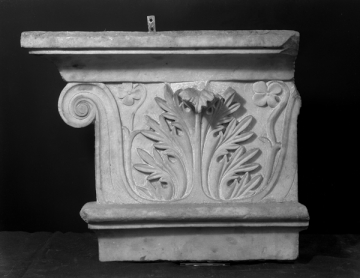Explore Collections


You are here:
CollectionsOnline
/
LEFT SIDE OF A COMPOSITE PILASTER CAPITAL (?)
Browse
LEFT SIDE OF A COMPOSITE PILASTER CAPITAL (?)
Not antique
Luna marble
Height: 41cm
Width: 48cm
Thickness: 10cm
Width: 48cm
Thickness: 10cm
Museum number: M1131
On display: Colonnade - north wall
All spaces are in No. 13 Lincoln's Inn Fields unless identified as in No. 12, Soane's first house.
For tours https://www.soane.org/your-visit
Curatorial note
Below an overhanging abacus a scroll volute in the shape of a wide lyre continued to the break at the right; between the horns of the lyre rises a large acanthus leaf with overhanging end and two flowered tendrils. The nature of the flower at the right, which curls in the same (left) direction as that at the left, indicates that the whole motive was redoubled beyond the break. The enrichment is separated from a smooth surface below by a set of mouldings similar to the abacus.
Although included with the ancient Roman fragments of the Tatham Collection, this pilastered carving cannot be considered antique. A larger, more elaborate example, dated most likely to the first century of the Empire, was found in the Tiber and is preserved in the Museo Nazionale Romano1. There is what appears to be a nearly identical pilaster capital (the little flower at the left turns inwards) drawn without indication of locality by Giuliano da Sangallo in Folio 10 of the Codex Barberini2 . It is an antique composition, however, as appears from the pilaster etched in the Villa Borghese by Piranesi3 and from the capitals preserved in the Arch of Augustus at Aosta4 ; Ronczewski has also collected and analysed a number of related antique prototypes for this capital, which are dated by him to the first century of the imperial period5 . They are all small pilaster capitals of a secondary decorative nature and include examples from the theatre at Ostia, Pompeii, and the Palatine (cp. also the provincial examples, at least two from a funerary monument, in Aquileia6 .
1 P. Gusman, L'Art décoratif de Rome de la fin de la république au IV siècle, Paris, 1910, III, pl. XXI.
2 Cod. Vat. Barb. Lat. 4424; Huelsen, Descrizione, p. 18.
3 De Rom. Mag., pl. XIII.
4 Ronczewski, Motive, fig. 101.
5 Anzeiger (Jahrbuch des Deutschen Archaologischen Instituts), 1934, cols. 31ff., esp. figs. 14 (Piranesi) - 18.
6 V. Scrinari, I Capitelli romani di Aquileia, Padua, 1952, i, nos. 10,a-c; and the more impressive pilaster capital, no. 8, which is related to those of the arches of Augustus at Aosta and Susa.
Although included with the ancient Roman fragments of the Tatham Collection, this pilastered carving cannot be considered antique. A larger, more elaborate example, dated most likely to the first century of the Empire, was found in the Tiber and is preserved in the Museo Nazionale Romano1. There is what appears to be a nearly identical pilaster capital (the little flower at the left turns inwards) drawn without indication of locality by Giuliano da Sangallo in Folio 10 of the Codex Barberini2 . It is an antique composition, however, as appears from the pilaster etched in the Villa Borghese by Piranesi3 and from the capitals preserved in the Arch of Augustus at Aosta4 ; Ronczewski has also collected and analysed a number of related antique prototypes for this capital, which are dated by him to the first century of the imperial period5 . They are all small pilaster capitals of a secondary decorative nature and include examples from the theatre at Ostia, Pompeii, and the Palatine (cp. also the provincial examples, at least two from a funerary monument, in Aquileia6 .
1 P. Gusman, L'Art décoratif de Rome de la fin de la république au IV siècle, Paris, 1910, III, pl. XXI.
2 Cod. Vat. Barb. Lat. 4424; Huelsen, Descrizione, p. 18.
3 De Rom. Mag., pl. XIII.
4 Ronczewski, Motive, fig. 101.
5 Anzeiger (Jahrbuch des Deutschen Archaologischen Instituts), 1934, cols. 31ff., esp. figs. 14 (Piranesi) - 18.
6 V. Scrinari, I Capitelli romani di Aquileia, Padua, 1952, i, nos. 10,a-c; and the more impressive pilaster capital, no. 8, which is related to those of the arches of Augustus at Aosta and Susa.
Rome; collected in Rome by Charles Heathcote Tatham for the architect Henry Holland during the 1790s. See Cornelius Vermeule, unpublished catalogue of the Antiquities at Sir John Soane's Museum, Introduction, transcription of Tatham letters, List 2, no. 23.
Literature
Tatham: Drawings, 1.
Soane collections online is being continually updated. If you wish to find out more or if you have any further information about this object please contact us: worksofart@soane.org.uk


